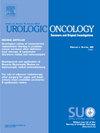根治性睾丸切除术后的康复:用一种新的电子患者报告结果(ePRO)平台详细介绍手术恢复情况。
IF 2.3
3区 医学
Q3 ONCOLOGY
Urologic Oncology-seminars and Original Investigations
Pub Date : 2025-03-20
DOI:10.1016/j.urolonc.2025.02.018
引用次数: 0
摘要
目的:评估电子患者报告结果平台的实施情况,恢复跟踪器,其特征是睾丸癌患者根治性睾丸切除术后的短期恢复。方法:根据程序代码为本院根治性睾丸切除术患者分配恢复跟踪器。术后10天每天对患者进行多个症状领域的调查。为了评估实施结果,根据人口统计学和疾病特征,将≥1次调查的应答者与无应答者进行比较。描述响应以确定跨域恢复。临床显著症状的确定基于报告“中度”或更严重程度,或“偶尔”或更高频率的回答。结果:从2021年6月至2023年10月,244例患者接受了睾丸切除术。236例(97%)接受调查,206例(87%)完成≥1次调查。美国麻醉医师协会的评分为3-4分(一种健康共病的测量方法,得分越高表明整体健康状况越差)与较差的反应率相关(P = 0.014)。在人口统计学或疾病因素(包括临床分期)之间,调查应答率没有其他差异。术后30天无Clavien-Dindo级≥2例并发症,1级并发症2例(0.8%)。在症状方面,大多数患者术后早期只有“疼痛”和“因疼痛而活动受限”为中度/重度。术后第5天,很少有患者出现中度或重度症状。结论:几乎所有接受根治性睾丸切除术的患者都成功地使用了恢复跟踪器。康复数据建立了明确的恢复基准,为术前预期症状提供指导,并识别潜在的术后异常过程,以便进行快速干预。本文章由计算机程序翻译,如有差异,请以英文原文为准。
Convalescence after radical orchiectomy: Detailing surgical recovery with a novel electronic patient reported outcome (ePRO) platform
Purpose
To assess implementation of an electronic patient reported outcomes platform, Recovery Tracker, which characterizes short term recovery following radical orchiectomy in patients with testicular cancer.
Methods
Recovery Tracker was assigned based on procedure codes to patients undergoing radical orchiectomy at our institution. Patients were surveyed daily for the 10-day postoperative period in multiple symptom domains. To assess implementation outcomes, responders of at ≥1 survey were compared to nonresponders based on demographic and disease characteristics. Responses were described to ascertain recovery across domains. Clinically significant symptoms were identified based on reporting “moderate” or greater severity, or “occasional” or higher frequency answers.
Results
From 06/2021 to 10/2023, 244 patients underwent orchiectomy. 236 (97%) were assigned a survey and 206 (87%) completed ≥1 survey. American Society of Anesthesiologists score of 3-4 (a measure of health comorbidities for which higher scores indicate worse overall health) was associated with worse response rates (P = 0.014). There were no other differences in survey response rates among demographic or disease factors, including clinical stage. There were no Clavien-Dindo Grade ≥2 30-day postoperative complications and 2 (0.8%) Grade 1 complications. Regarding symptomatology, only “pain” and “limited activities due to pain” were reported to be moderate/severe among most patients early in the postoperative period. After postoperative day 5, very few patients reported moderate or severe symptoms.
Conclusions
Recovery Tracker was successfully assigned to and completed by nearly all patients undergoing radical orchiectomy. Convalescence data establishes clear recovery benchmarks to provide preoperative guidance on expected symptoms and identify potential abnormal postoperative courses for rapid intervention.
求助全文
通过发布文献求助,成功后即可免费获取论文全文。
去求助
来源期刊
CiteScore
4.80
自引率
3.70%
发文量
297
审稿时长
7.6 weeks
期刊介绍:
Urologic Oncology: Seminars and Original Investigations is the official journal of the Society of Urologic Oncology. The journal publishes practical, timely, and relevant clinical and basic science research articles which address any aspect of urologic oncology. Each issue comprises original research, news and topics, survey articles providing short commentaries on other important articles in the urologic oncology literature, and reviews including an in-depth Seminar examining a specific clinical dilemma. The journal periodically publishes supplement issues devoted to areas of current interest to the urologic oncology community. Articles published are of interest to researchers and the clinicians involved in the practice of urologic oncology including urologists, oncologists, and radiologists.

 求助内容:
求助内容: 应助结果提醒方式:
应助结果提醒方式:


